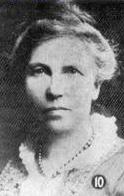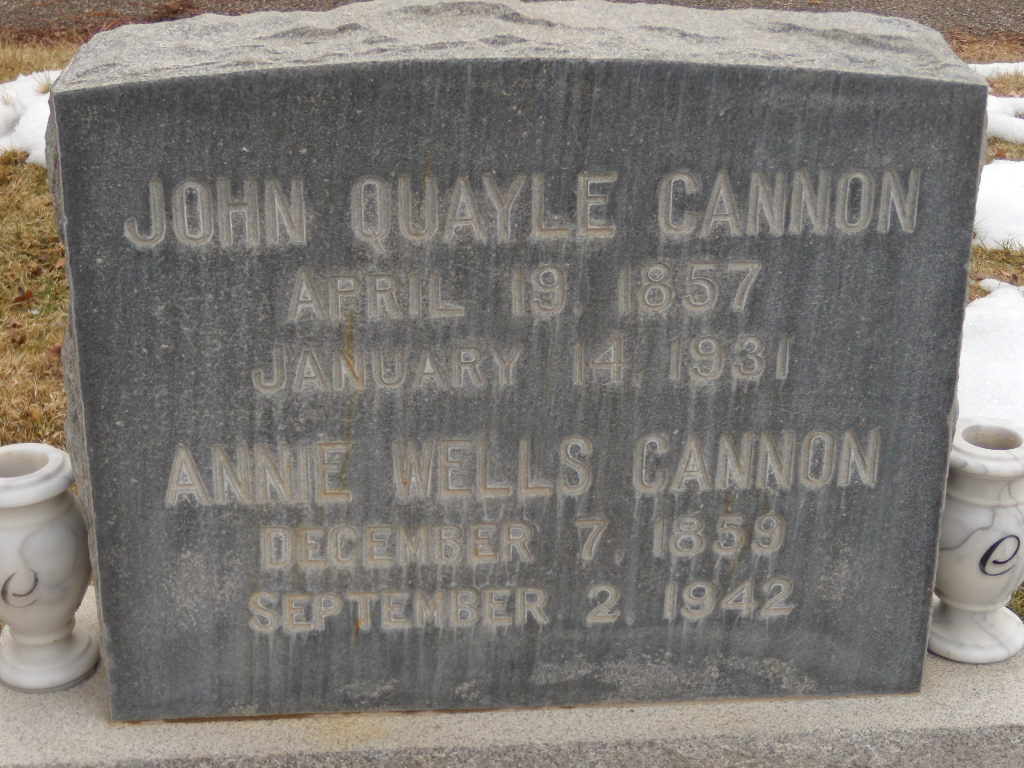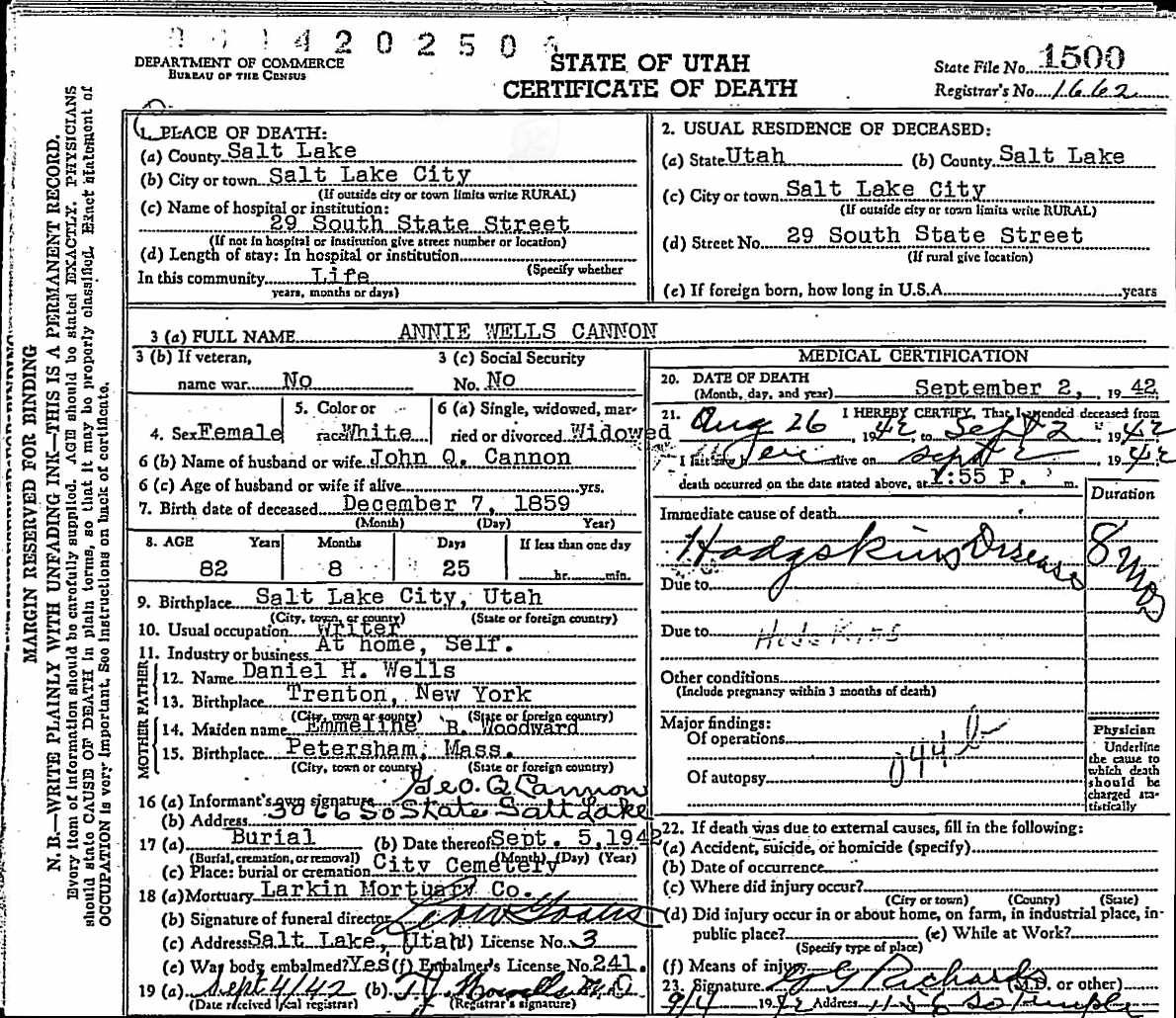An Enduring Legacy, Volume One, p. 233
Annie was a daughter of Daniel Hanmer and Emmeline Blanche Woodward Wells. She was born December 7, 1859, in a two-story adobe house on State Street between Second and Third South streets in Salt Lake City. From this vantage point, she watched the wagon trains and handcarts come into the valley. She attended the best schools available at that time, including the Deseret University. She was taught at an early age the useful and beautiful things of life, including appreciation of good books, good music, drama and opera, and was encouraged to write. The best books and papers that could be obtained were brought into this home and with her dear mother, whom she adored, she and her sisters read, studied and dramatized together.
Naturally a religious child, she had an almost perfect attendance at Sunday School, once wading through deep snow to find only one member of the superintendency had braved the storm. On her tenth birthday her father gave her a New Testament, which she felt it her duty to read, but ever after it became an inspiration and a guide throughout her life. At age fourteen she became a member of the Relief Society, a membership she held until the time of her death.
At age twenty she became the wife of John Quayle Cannon, a prominent and public-spirited man. In 1881 he was called to fulfill a mission in the British Isles, working first in England. Later he was transferred to Germany. In 1883 she joined her husband and spent a delightful year sightseeing as well as doing missionary work. During this time she wrote the History and Objectives of the Relief Society, which was translated and published in several languages.
John Quayle, always interested in military life, became active in the National Guard and for many years was adjutant and brigadier general of this organization. He also became a volunteer in the Spanish American War and he was elevated to the rank of Lieutenant Colonel as a result of this service.
At the beginning of World War I, Annie became actively engaged in the Red Cross, organizing and directing Red Cross chapters in Utah. She became affiliated with the War Mothers' group and was elected president. She was also twice state president of the Service Star Legion and was active on the committee for the establishment and development of the Memory Grove Memorial. She spent many hours organizing and placing canteens at various stations for the local boys or other boys just passing through who were meeting trains day or night. She was chosen by Herbert Hoover, who later became President of the United States, to be Utah's chairman for the European Relief Drive. In 1918 she was elected an associate vice-president of the American Flag Association, a national organization, and was appointed by the governor to serve on the committee for the official welcome to the state's twenty-two thousand heroes at the end of World War I.
She was asked to be on the reception committee when President Wilson and his party visited Utah. She recalled with much pleasure that this was not the first time she had greeted a President of the United States. As a little girl, dressed in white, with a wreath of flowers on her head and a flag in her hand, she stood in line with hundreds of Sunday School children to greet President Ulysses S. Grant as he rode through the streets of Salt Lake. In 1880 she was chosen to go out on the train to meet President Hayes and his party on the occasion of his visit to Utah.
In 1934 she was awarded a medal and given a testimonial as one of the seven outstanding women in civic service in the state of Utah. Among her various accomplishments was her service as assistant editor of the Woman's Exponent, the first women's paper published in the Mountain States. She contributed prose and poetry to popular magazines, co-authored the Relief Society Handbook, and was author of biographical sketches of many prominent women. As a member of the Republican Party, she was elected in 1921 to the Utah State Legislature, and was one of the three women largely responsible for the passage of the extensive social program for the betterment of women and children, the minimum wage for women, better working conditions, and cooperated in the passage of the Dependent Mother's Pension Law.
A charter member of the Daughters of Utah Pioneers, she was among the first to promote the idea of saving relics, restoring landmarks and writing histories to preserve our heritage. During her term of office, the Daughters helped sponsor the Twenty-fourth of July celebration and inaugurated the honoring of past presidents and charter members of the society. She helped in the selection of the site for the permanent building and from the beginning was active in raising funds for it. In 1910 she and Amy Brown Lyman attended a special meeting of the Daughters where all the charter members were invited guests. At this event Annie was asked to be the speaker and dedicated her talk largely to the society's cherishing and preserving the historical narratives of the pioneers and handing them down to posterity.
With all of her activities, the Relief Society was her primary interest. In October 1902, she became a member of the Relief Society General Board, participating in many and varied projects. Following the San Francisco earthquake, April 21, 1906, she was among those called to gather and supervise the sending of supplies to the earthquake sufferers. In 1906 she aided in the preparation of a pamphlet on the question of saving wheat, which was distributed among the Relief Societies. Responding to a call from the Presiding Bishopric of the LDS Church, a supply of linen for the Groves LDS Hospital, then nearing completion, was obtained. After her mother, Emmeline B. Wells, became the general president of the Relief Society, she was able to help her in many ways, especially with the Woman's Exponent. At this time she was doing nearly all the writing, editing, proofreading, and taking charge of the publishing and mailing.
For more than fifty years Annie and her husband John enjoyed love, companionship and mutual understanding, watching the growth and development of children and grandchildren. Twelve children were born to this outstanding couple, eleven of whom grew to maturity in a home that provided loyalty, courtesy and affection. It was a truly happy home according to her daughter, Margaret Cannon Clayton, who provided the information from which this biography was taken. She stated that death came to Annie Wells Cannon September 2, 1942, and comments: "Mother died as she had lived, calm, serene and majestic, ready to meet her loved ones and ready to go forward to greater heights. Certainly her cup of life was filled to the brim. President David O. McKay, one of the speakers at the funeral service, closed his remarks by saying, 'All her activities were incidental to her crowning glow of motherhood.'"
-------------------------
An Enduring Legacy, Volume One, p. 233
Annie was a daughter of Daniel Hanmer and Emmeline Blanche Woodward Wells. She was born December 7, 1859, in a two-story adobe house on State Street between Second and Third South streets in Salt Lake City. From this vantage point, she watched the wagon trains and handcarts come into the valley. She attended the best schools available at that time, including the Deseret University. She was taught at an early age the useful and beautiful things of life, including appreciation of good books, good music, drama and opera, and was encouraged to write. The best books and papers that could be obtained were brought into this home and with her dear mother, whom she adored, she and her sisters read, studied and dramatized together.
Naturally a religious child, she had an almost perfect attendance at Sunday School, once wading through deep snow to find only one member of the superintendency had braved the storm. On her tenth birthday her father gave her a New Testament, which she felt it her duty to read, but ever after it became an inspiration and a guide throughout her life. At age fourteen she became a member of the Relief Society, a membership she held until the time of her death.
At age twenty she became the wife of John Quayle Cannon, a prominent and public-spirited man. In 1881 he was called to fulfill a mission in the British Isles, working first in England. Later he was transferred to Germany. In 1883 she joined her husband and spent a delightful year sightseeing as well as doing missionary work. During this time she wrote the History and Objectives of the Relief Society, which was translated and published in several languages.
John Quayle, always interested in military life, became active in the National Guard and for many years was adjutant and brigadier general of this organization. He also became a volunteer in the Spanish American War and he was elevated to the rank of Lieutenant Colonel as a result of this service.
At the beginning of World War I, Annie became actively engaged in the Red Cross, organizing and directing Red Cross chapters in Utah. She became affiliated with the War Mothers' group and was elected president. She was also twice state president of the Service Star Legion and was active on the committee for the establishment and development of the Memory Grove Memorial. She spent many hours organizing and placing canteens at various stations for the local boys or other boys just passing through who were meeting trains day or night. She was chosen by Herbert Hoover, who later became President of the United States, to be Utah's chairman for the European Relief Drive. In 1918 she was elected an associate vice-president of the American Flag Association, a national organization, and was appointed by the governor to serve on the committee for the official welcome to the state's twenty-two thousand heroes at the end of World War I.
She was asked to be on the reception committee when President Wilson and his party visited Utah. She recalled with much pleasure that this was not the first time she had greeted a President of the United States. As a little girl, dressed in white, with a wreath of flowers on her head and a flag in her hand, she stood in line with hundreds of Sunday School children to greet President Ulysses S. Grant as he rode through the streets of Salt Lake. In 1880 she was chosen to go out on the train to meet President Hayes and his party on the occasion of his visit to Utah.
In 1934 she was awarded a medal and given a testimonial as one of the seven outstanding women in civic service in the state of Utah. Among her various accomplishments was her service as assistant editor of the Woman's Exponent, the first women's paper published in the Mountain States. She contributed prose and poetry to popular magazines, co-authored the Relief Society Handbook, and was author of biographical sketches of many prominent women. As a member of the Republican Party, she was elected in 1921 to the Utah State Legislature, and was one of the three women largely responsible for the passage of the extensive social program for the betterment of women and children, the minimum wage for women, better working conditions, and cooperated in the passage of the Dependent Mother's Pension Law.
A charter member of the Daughters of Utah Pioneers, she was among the first to promote the idea of saving relics, restoring landmarks and writing histories to preserve our heritage. During her term of office, the Daughters helped sponsor the Twenty-fourth of July celebration and inaugurated the honoring of past presidents and charter members of the society. She helped in the selection of the site for the permanent building and from the beginning was active in raising funds for it. In 1910 she and Amy Brown Lyman attended a special meeting of the Daughters where all the charter members were invited guests. At this event Annie was asked to be the speaker and dedicated her talk largely to the society's cherishing and preserving the historical narratives of the pioneers and handing them down to posterity.
With all of her activities, the Relief Society was her primary interest. In October 1902, she became a member of the Relief Society General Board, participating in many and varied projects. Following the San Francisco earthquake, April 21, 1906, she was among those called to gather and supervise the sending of supplies to the earthquake sufferers. In 1906 she aided in the preparation of a pamphlet on the question of saving wheat, which was distributed among the Relief Societies. Responding to a call from the Presiding Bishopric of the LDS Church, a supply of linen for the Groves LDS Hospital, then nearing completion, was obtained. After her mother, Emmeline B. Wells, became the general president of the Relief Society, she was able to help her in many ways, especially with the Woman's Exponent. At this time she was doing nearly all the writing, editing, proofreading, and taking charge of the publishing and mailing.
For more than fifty years Annie and her husband John enjoyed love, companionship and mutual understanding, watching the growth and development of children and grandchildren. Twelve children were born to this outstanding couple, eleven of whom grew to maturity in a home that provided loyalty, courtesy and affection. It was a truly happy home according to her daughter, Margaret Cannon Clayton, who provided the information from which this biography was taken. She stated that death came to Annie Wells Cannon September 2, 1942, and comments: "Mother died as she had lived, calm, serene and majestic, ready to meet her loved ones and ready to go forward to greater heights. Certainly her cup of life was filled to the brim. President David O. McKay, one of the speakers at the funeral service, closed his remarks by saying, 'All her activities were incidental to her crowning glow of motherhood.'"
-------------------------
Family Members
-
![]()
Rev Albert Emory Wells
1839–1916
-
Eugene Henri Harris
1844–1844
-
![]()
Isabel Modelena "Belle" Whitney Sears
1848–1941
-
![]()
Daniel Hanmer Wells Jr
1849–1926
-
![]()
Melvina Caroline Blanche Whitney Woods
1850–1940
-
![]()
Frances Louisa "Fannie" Wells
1852–1944
-
![]()
Abbie Corilla Wells Young
1852–1930
-
Catherine Alley Wells
1853–1922
-
![]()
Junius Free Wells
1854–1930
-
![]()
Mary Minerva Wells Whitney
1854–1935
-
![]()
Martha Deseret Wells Read
1854–1886
-
![]()
Rulon Seymour Wells
1854–1941
-
![]()
Luna Pamela Wells
1856–1857
-
![]()
Susan Annette Wells Culmer
1857–1929
-
![]()
Emeline Young Wells
1857–1941
-
![]()
Emily Harris Wells Grant
1857–1908
-
![]()
Lucy Ann Wells
1858–1859
-
![]()
Eliza Free Lyde Wells
1859–1940
-
![]()
Heber Manning Wells
1859–1938
-
![]()
Brigham Wells
1859–1863
-
George A Wells
1859–1872
-
![]()
Preston Strait Wells
1861–1861
-
![]()
Clara Ellen Wells Hedges
1862–1946
-
![]()
Joseph Smith Wells
1862–1916
-
![]()
Louis Robison Wells
1862–1952
-
![]()
Ephraim Willard Wells
1863–1863
-
![]()
Gershom Britain Finley Wells
1864–1944
-
![]()
Melvin Dickinson Wells
1867–1941
-
Wilford Woodruff Wells
1868–1868
-
![]()
Victor Pennington Wells
1868–1927
-
![]()
Edna Margaret Wells Sloan
1869–1935
-
![]()
Charles Henry Wells
1870–1944
-
![]()
Arthur Deming Wells
1871–1871
-
![]()
MAJ Briant Harris Wells
1871–1949
-
![]()
George Quayle Cannon
1881–1967
-
![]()
Louise Blanche Cannon Andrew
1884–1967
-
![]()
Margaret Cannon Clayton
1886–1977
-
![]()
Daniel Hoagland Cannon
1889–1954
-
![]()
Eleanor Addy Cannon
1891–1892
-
![]()
Emmeline Cannon Martineau
1893–1972
-
![]()
Cavendish Wells Cannon
1895–1962
-
![]()
Katherine Cannon McKay
1897–1947
-
![]()
David Woodward Cannon
1899–1973
-
![]()
Abraham Hoagland Cannon
1899–1992
-
![]()
John Quayle Cannon Jr
1901–1980
-
![]()
Theodore Lincoln "Ted" Cannon
1904–1966
Sponsored by Ancestry
Advertisement
Records on Ancestry
Advertisement





















































